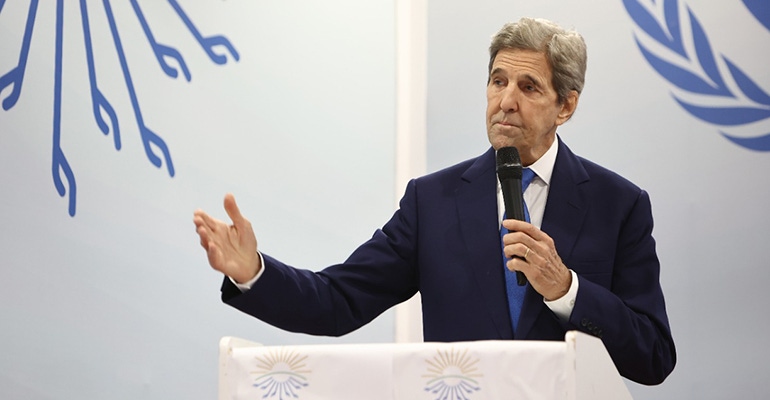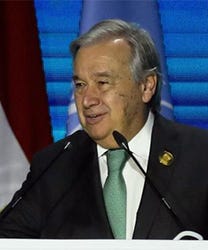Climate change affects various countries differently, which raises issues of justice and equity in the food system and beyond. Resolving such disparities is critical, says the United Nations secretary general.

The natural products industry spends considerable time and energy discussing climate change and, in particularly, the food system’s role in the increasing global temperature.
Officials and activists from around the world are again meeting to discuss climate change. Last week, the 27th United Nations Climate Change Conference, known as COP27 started; this time, it’s in Sharm el-Sheikh, Egypt.
The New York Times has compiled a 12-question list of things to know about COP27, while New Hope Network offers this roundup of news focusing on justice and equity surrounding the climate change crisis.
The urgency of climate change mitigation
During a two-day Climate Implementation Summit that immediately preceded the COP27 conference, UN Secretary-General António Guterres called for a Climate Solidarity Pact, through which developed and developing countries would reach agreements to reduce emissions, end dependence on fossil fuels and provide sustainable energy for everyone, the United Nations news service reports.
“The two larg
“Solidarity that respects all human rights and guarantees a safe space for environmental defenders and all actors in society to contribute to our climate response. Let’s not forget that the war on nature is in itself a massive violation of human rights,” he says.
Guterres’ demands reflect, in part, developing countries’ wanting a “loss and damage” fund to help them recover from disasters. John Kerry, U.S. Special Envoy for Climate under President Joe Biden, tells Reuters, though, that the United States would not support that move.
“We will find a way, I am confident, to be able to have financial arrangements that reflect the reality of how we are all going to deal with the climate crisis,” Kerry says.
The countries of Africa are among the most vocal demanding a “loss and damage” fund, as the continent is experiencing some of the most devastating climate-related weather events—even though it creates less than 4% of the world’s carbon emissions, according to Foreign Policy. Flood have destroyed West African food production, while drought is causing famine in East Africa. In North Africa, extreme heat and wildfires are raging, while cyclones are ravaging Southern Africa.
The African Development Bank estimates that Africa is losing up to 15% of its gross domestic product per capita growth annually because of climate change, Foreign Policy reports.
COP27 continues this week, as will the loss and damage debate. Continue reading for other news of interest to the natural products industry.
Increasing nutrient density for resilience
Food Tank and the Food Systems Pavilion organized a discussion regarding access to healthy food at COP27.
“Food is a human right,” says Monica Yator, founder and executive director of the Indigenous Women and Girls Initiative, a nonprofit founded in 2020, in Kenya. “It is also a basic need.” The initiative introduces women to crop farming, which women are allowed to participate in, even though they cannot own land. Its mission is to support women and amplify their voices to ensure their rights are protected and that they are involved in decision-making processes.
The Self Employed Women’s Association, known as SEWA, encourages women to grow nutrient-rich, traditional foods as industrialized farming is stripping foods of nutrients.
“Women form an integral part of the entire food system, from product to household consumption and disposal of food,” says Mansi Shah, documentation and design consultant for SEWA.
Read more and watch a video at Food Tank.
COP27: Building a regenerative economy through a just transition
Slashing through the alphabet soup that embroils sustainability actions and reports, a new term might be rising to the top: a just transition.
The international trade union movement has long promoted this term to describe climate action plans that are “socially equitable, financially viable and environmentally regenerative.” More than 30 countries—including the United States, Canada and members of the European Union—signed at COP26 the Glasgow Just Transition Declaration, which set goals of creating sustainable, green and inclusive economies and decarbonizing economies to limit the global average temperature increase.
“A lot of the guides on just transition are targeting governments to help them establish just transition frameworks. It’s not clear what’s expected of businesses yet, and it can be scary to stick your head above the parapet.,” says Haley St. Denis, head of just transition at the Institute for Human Rights and Business.
Read more at Triple Pundit.
A just transition depends on energy systems that work for everyone
As Russia’s war in Ukraine continues to limit global oil supplies, rich countries in the West are pushing for more fossil fuel projects in Africa.
Such projects, which are being called out as energy colonialism, won’t benefit the surrounding communities, either with more energy or better economies. It’s estimated that, because most fossil fuels extracted in Africa are exported, about 600 million people lack access to electricity.
“It’s not just about the energy source, it’s about the whole energy system—who decides, who benefits and who profits,” says Dipti Bhatnagar of Friends of the Earth International in Mozambique.
“This is not just transition, this is land grabbing,” says John Tingoi of the Indigenous Movement for Peace Advancement and Conflict Transformation (Impact) in northern Kenya. “If you violate people’s basic rights and the communities have no benefits, it can never be just.”
Read more at The Guardian.
A new website shows where greenhouse gas emissions actually come from
Climate Trace, a new website, uses satellites as well as sensors on land, airplanes and ships to determine the exact sources of worldwide greenhouse gas emissions.
The website has found that 26 of the top 50 sources are oil and gas operations—an industry known for under-reporting its carbon dioxide and methane pollution.
The website’s goal is to publicize the source of greenhouse gas emissions and force governments and countries to solidify their efforts to reduce the emissions.
Climate Trace includes a searchable map.
Read more at NPR.
About the Author(s)
You May Also Like




